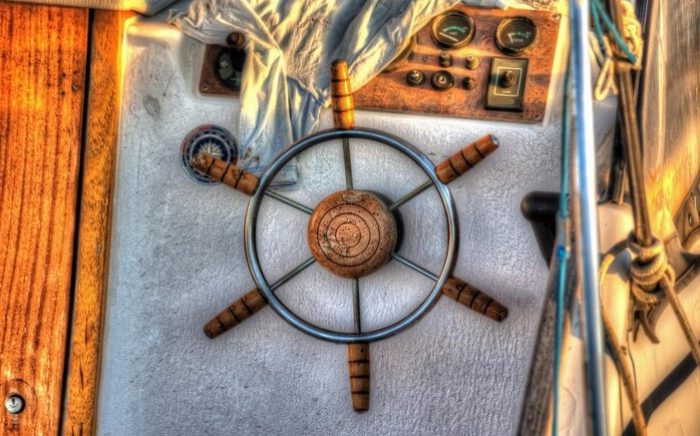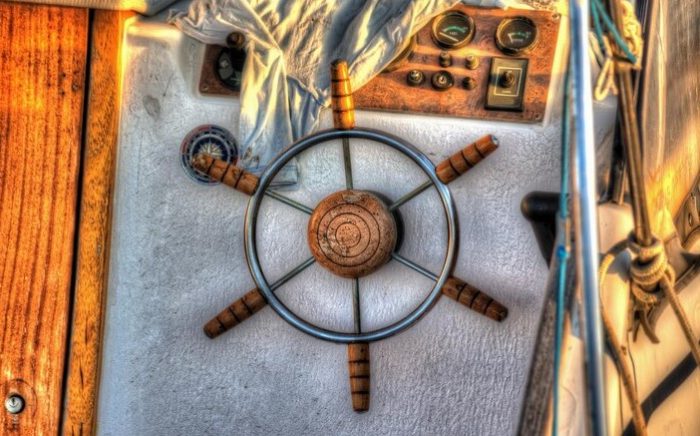Most boaters refer to the steering wheel as the helm. This is because they often use a variety of words that mean “steering wheel.” You can safely assume that generic terms, like “helm” and “wheel,” are referring to the steering wheel.
Key Takeaways
- The person who steers the boat is called the helmsman or helmswoman
- The helm is used to control the boat’s rudder, which helps to steer the boat in the desired direction
- The steering wheel on a boat is typically located near the back, or stern, of the boat
- The steering gear system of a boat typically consists of a steering wheel or other type of input device, a hydraulic or mechanical linkage, and the rudder itself
The helm

In modern maritime, the helm is the phrase associated with the steering wheel of a boat or ship. It can be in various forms, including tiller and toggle, used on larger ships connected to remote control or console. However, helm can also refer to a place where the boat or vessel is controlled. Apart from the wheel, navigation and communication tools are kept at the helm. In the ships, the helm is located in a big area dedicated to controlling the entire vessel.
The Location of the steering wheel
Are you familiar with the parts of the boat? Let’s rush through some basic body parts of the boat for a few seconds. We have a bow, which is the front part of the boat, and the stern is the rear part. The sideways of the boat are called portside (left-hand side) and starboard side (right-hand side), and not left and right side. Having known that, now let’s get back to the topic. The steering wheel on a boat is located on the starboard side. The port side is where you disembark from the boat when docking in the marina.
Understanding the steering gear system
For many years, we have had various gear systems used in boats, vehicles, and other vessels. Most of the current gear systems use one of two options; the first one is recirculating ball steering system, and the second is the rack and pinion system. The rack and pinion system is the most used system. However, the recirculating ball steering system is still found in vehicles, including the pitman arm that uses it to transfer movement to the steering system.
Do you inspect the steering gear system and power steering? If not, you should check them at least once a year; you can use ASE certified technician to do the inspection. The majority of people don’t like doing the assessment, which puts their lives in danger. Checking the well-being of your vessel ensures that the components are in good condition and safe to use. Get peace of mind by providing that your vehicle is properly inspected.
How the steering wheel works


Do you know how the steering wheel works? The wheel is used to steer the boat or ship and adjust the direction of where the vessel is going. It is connected to the rudder, which affects the ship’s movement. If you compare the helm’s position in old and modern boats and boats, you find that; in the old boats and yachts, the helm is located near the stern to ease the connectivity to the rudder. The area is kept at an elevation when controlling the vessel from the helm to ensure that the surrounding is more visible
When it comes to modern boats and ships, the helm can be located away from the stern, and with the emergence of technological advancement, the wheel can be placed further from the rudder without affecting the control system. In much bigger ships, the helm may also be elevated to help survey the area surrounding the vessel.
The rudder
When you turn a steering wheel, it adjusts the rudder hence changing the ship’s direction. The rudder is located at the ship’s stern under the water. The ship’s keel guides the water flow towards the stern as the rudder changes the vessel’s direction towards the desired angle. For the boat and other water vessels that use a motor, the rudder is placed at the stern behind the propeller to increase its performance. Rudders are designed differently, and some ships use more than one rudder. Even though the weight of the vessel affects how the rudder functions, large ships have more specialized rudder designs that are installed for effective and efficient use.
Modern ship control
The weight and size of modern ships pose a challenge in controlling them. In the old vessels, the strength of the helmsman was relied on to steer the wheel in the right direction. The flow of the water against the rudder creates a resistance force that makes the wheel heavy to control. In modern ships, hydraulic steering systems and wheels are used to control and change the ship’s direction, thus giving the captains an easy time. Remember that you must have a specific time for turning your boat, as it responds to changes in the surrounding area on time.
The hydraulic steering system helps to;
- To combat the resistance created by the flow of water against the rudder of the ship.
- To ensure that there is a specific time of response to turn the larger rudder of the ship.
- To provide a fail-safe for specific emergencies.
Boats have come a long way from traditional ones. The steering wheels are small, others smaller than those found in the cars. If you think a boat needs more complicated steering systems and oversized wheels to perform well, you are wrong. They are small, faster, and more advanced than the large and rounded steering wheels used in traditional designs.
No matter how heavy the ship is, with the help of modern hydraulic steering, the boat can be steered by a single person. Remember, due to the complexity of mechanisms, a crew of engineers and experts is required to manage these systems.
Alternative to the wheel
Some other boats use tillers instead of the steering wheel to control the rudder. Do you know what a tiller is? It’s a long rod made of wood or metal that is used to turn side-to-side to change the angle of the rudder. A tiller was mostly used to steer both boats and ships in the past. Those used to drive ships were somehow large, and they needed multiple people to steer the boat because of the heaviness. Some modern boats may still have tillers, but for smaller vessels below 30 feet long, those that are more than that do not use tillers.
Benefits of a tiller
- Tiller takes up low space compared to a steering wheel; therefore, it makes more sense to be used in small boats.
- A tiller is more accurate and responsive than a steering wheel, as it is connected directly to the rudder, so any change made to the rudder through the tiller makes an immediate response. This makes it to be perfect for fishing and trolling.
How Tillers function
Tillers are connected to rudders alone, and tillers and rudders can also be connected to the same shaft. No matter where it is connected, the tiller will still perform top-level in controlling the boat. What is the biggest difference between the tiller and the wheel? The difference is how they turn the boat. For the tiller, the boat turns in the opposite direction of the tiller. For instance, the boat will move in the right direction when turning the tiller to the left. This simplicity of the tiller gives it added advantage over the steering wheel.
Frequently asked questions
This section answers some of the frequently asked questions as it provides more information that we may have failed to give in the other areas.
Why is the steering wheel in a boat on the right?
We believe that the steering wheels of the boats and ships are located on the starboard side to help the helmspersons to operate them using their right hands. Since most people are right-handed, the wheel is on the right-hand side, making it naturally comfortable. From the historical perspective, humans are predominantly right-handed. They carried their shields in their left hand and a weapon in their right hand. Also, from the boat guidelines, steering boards should be kept on the starboard side.
What is the steering wheel on a pirate ship? Called
in literature and film, the steering wheel of the pirate’s boat is often known as the helm. The helm controls the rudder, which adjusts the direction of the ship.
What does a ship steering wheel symbolize?
You may have seen some logos, patterns, or tattoos that symbolize a ship and boat steering wheels and wonder what the meaning is. Those that use these symbols may have reasons behind it. Some wear them as a remembrance of their time at sea. It may symbolize the person looking to navigate their way through life’s rough and unexpected seas. Historically in the Middle Ages, the steering wheel was used to represent leadership and management, which makes sense when you critically think about it.
Conclusion
After going through this article, we hope that now you have a better understanding of the question as we have also discussed the rudder, tiller, and how it works, without forgetting frequently asked questions. Enjoy your time on the water!
References:
- https://pontoonopedia.com/what-steering-wheel-on-boat-called/
- https://www.boatingbasicsonline.com/what-is-the-steering-wheel-on-a-ship-called/

Rockey is a kayaking enthusiast who has been kayaking with a local group for the last five years. He loves using kayaks while out on outings on the water or camping when the friends want to have a BBQ party somewhere on the bank of a local lake. More About James R Rockey at About Page Here: Authors
Based on his experiences with the different types of kayaks, he is sharing his opinion about kayaking tricks and required gears so that a beginner can get started right away.
Find his team on Twitter here. Happy reading!
